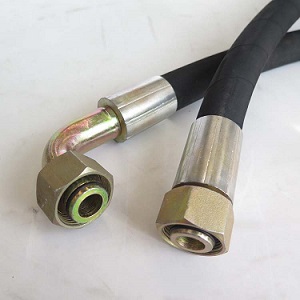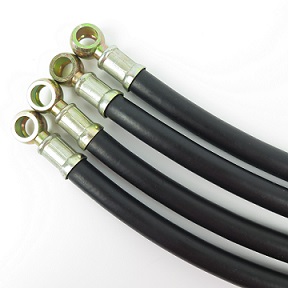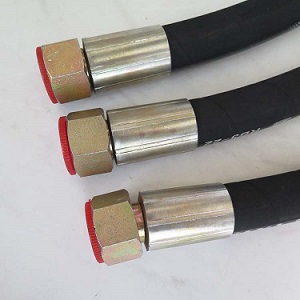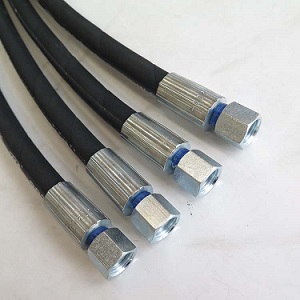How Should We Choose A Suitable Hose?
Hydraulic hose and hose assembly have service life according to their work environment. If the work environment of the hose assembly is worse than recommendation condition, the service life of the hose assembly may be reduced. When several conditions are close to the recommendation value at the same time (namely, under the max allowable work pressure, highest work temperature, and min bending radius for a long time),the service life may be also reduced.
The following factors should be considered in the selection of hose:
1.Hose dimension
In order to achieve max efficiency in hydraulic system, min pressure loss is needed when the fluid flows through various pipes.
When the fluid flows through the pipe, the heat generates from the friction.
This part of heat disappears by means of heat energy, which leads to pressure loss.
Pressure loss depends on:
. Flow speed (for the fluid with fixed volume, the flow speed increases when the flow area decreases; vice verse). Length of the fluid. Viscosity of the fluid. Density of the fluid
. Flow type (flow layer or turbulence)
2.Pressure
Every type of hose has a recommended max work pressure. After the system pressure of the hydraulic system, the max work pressure of the selected hose should be greater or equal to the system pressure. Peak pressure beyond max work pressure must be considered for it may influence the service life of system elements (including hose assembly). The hose for input line must not be absorbed flat under the negative system pressure.
3.Temperature
The fluid temperature and environmental temperature in work should not be beyond allowable temperature range of the hose. When the hose line is close to the heat source including melt metal, the user must take particular care and protect the hose line by appropriate measures.
4.Fluid Compatibility
The compatibility between the fluid and inner layer, external glue layer, enhanced layer, and joint of the hose must be considered in the selection of hose. Special hose should be used for some fluids. However, no hose can be used for some fluids.
5.Permeability
When the hose is used for gas, liquefied gas or fuel gas, refrigerating fluid (including helium, fuel oil, natural gas, and Freon), the gas may permeate from inside of the hose to outside of the hose. The penetration may
lead to high concentration combustible, explosive, and poisonous gas and fluid loss.
Therefore, even when some mediums have appropriate compatibility, the permeability must also be considered.
Steam may permeate from outside of the hose to inside of the hose. If the steam penetration is harmful to the system (such as refrigerating fluid and air conditioning system), the device in the system must have sufficient drying ability. Or other appropriate saturation devices must be used.
6.Pipeline arrangement
In order to avoid hose failure, most suitable pipeline must be arranged. When necessary, the hose is protected and guided by fixed pipe clamp to avoid excessive bending, movement, or contact and erosion with other moving parts. Suitable length and structure of the hose must be determined to arrange smooth and reasonable pipeline.
7.Environment
The hose and joint must be compatible with the environmental conditions. Environmental conditions include ultraviolet ray, heat, ozone,humidity, water, saline water, chemicals, and polluted air. All of these can reduce the performance of the hose or lead to earlier failure.
8.Mechanical Load
External force can obviously reduce the service life of the hose. Mechanical loads including excessive bending, wrapping, torsion,extension, side pressure, bending radius, and vibration must be considered. Convertible joint can keep the hose from torsion. An experiment is needed in the selection of the hose for special usage.
9.Attribution
The hose can resist certain attributions. However, necessary measures should be taken to protect the hose in the place with strong friction. Or else, the hose may be damaged when its external glue layer is broken. When the enhanced layer is exposed, the hose may lose effect significantly earlier.
10.Length
Part movement, change of hose length under pressure, hose tolerance, and machine tolerance must be considered in the determination of hose length.
11.Specification and Standard
In the selection of hose and joint, the products in line with national standard, industrial standard, and specification and recommendation of the manufacturer must be considered.
12.Cleanness degree of the hose
Certain cleanness degree must be guaranteed for hose assembly. The cleanness degree of the assembly must be in line with requirement of the application system.
13.Welding
Fatal gas will come out when the temperature of joint welding excesses 232 C.
14.Electrical conductivity
Usually, the hose should be with insulated. However, under some situations, the hose should have good electrical conductivity to release the static.
As to electrical conductivity or insulation, the following affairs must be paid attention to: when good insulation is required for the hose(near the high voltage wire), insulated hose must be used.
Electric conductivity or insulation of the hose and the joint is determined by many factors including: material and manufacturing technology of the hose and the joint (including temperature control), connection mode of the hose and the joint, use time of the hose, degree ofaging, and humidity of the hose in special period.




Contact us:
Tel&WhatsApp: 008615603181872
Email: alana@chnhose.com
Wechat: 008615603181872
Skype: alana989752